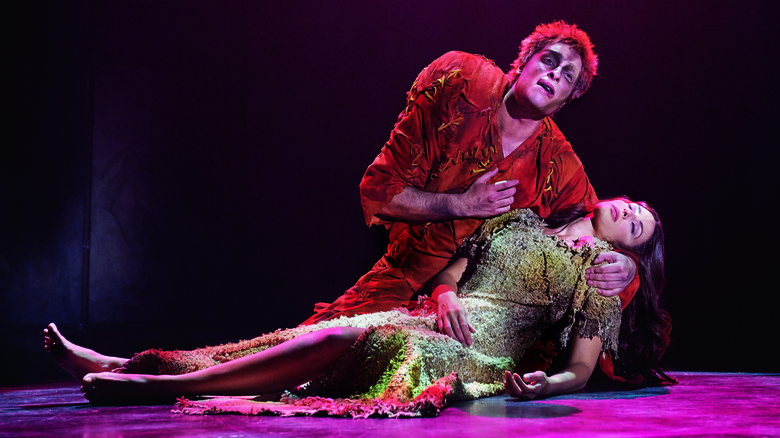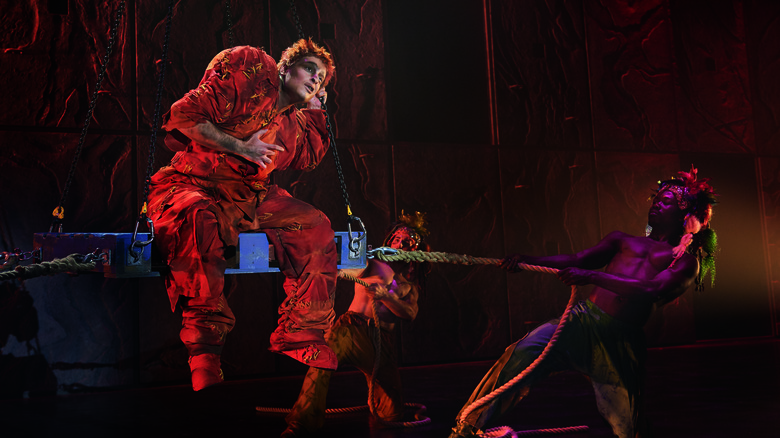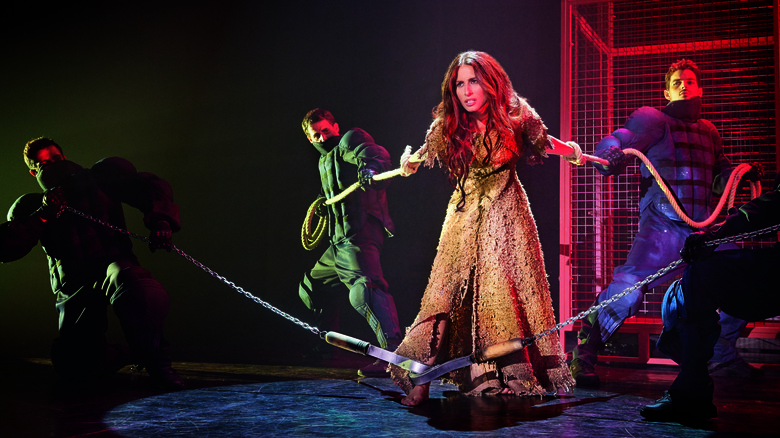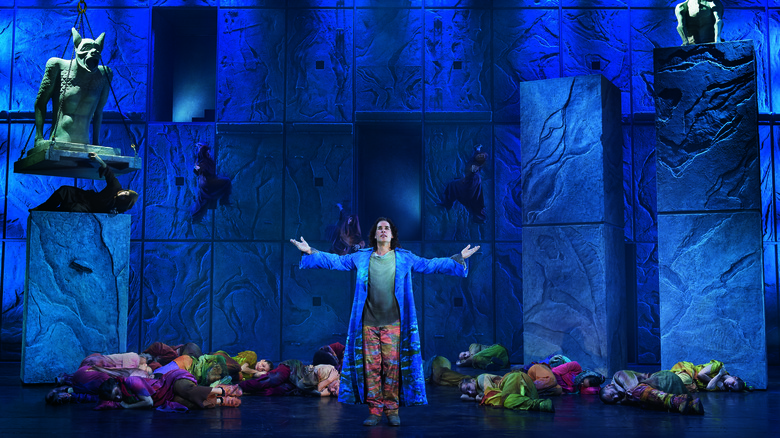Notre Dame De Paris Review: This French Musical Goes Hard On Showy Spectacle
It's hard not to float into the clouds when Gian Marco Schiaretti, as the poet Gringoire, bellows the stratospheric "Le temps des cathédrales" (translated as "The Age of the Cathedrals," and perhaps well known to Americans who heard Josh Groban's "Stages" album). Debuting in 1998 in Paris, the sung-through "Notre Dame de Paris" French musical catapulted into meteoric international fame. So much hype was kindled around the long-awaited NYC premiere and limited run. Composer Richard Cocciante's score and Luc Plamondon's songwriting is transportive, not so much for situating you in medieval Paris of this Victor Hugo-adapted tale, but rather a vibe. The river of music whisks you through its 2 hour runtime, though not quite cleansing some of its poorly-aged obstinances. Sitting from the discounted left orchestra at the David H. Koch Theater at Lincoln Center, "Notre Dame de Paris" was indisputably gorgeous from that vantage point. I say this as someone who only digested the Sparknotes of the Victor Hugo source material novel (and know the comparatively sunnier but dark-for-Disney standards 1997 "The Hunchback of Notre Dame" musical animated feature) that may aid in charting its romantic entanglements.
In medieval Paris, social upheaval is screaming at the gates of the grand Notre Dame cathedrals. Led by Clopin (Jay), paperless immigrants and the homeless plead for sanctuary in the church walls. In the midst of it all, a Romani street performer, Esmeralda (Hiba Tawaji), becomes an object of desire between three men: the corrupt Notre Dame archdeacon Frollo (Daniel Lavoie) who hates her people, the dashing but unfaithful captain of the guard Phoebus (Yvan Pedneault), and the hunchbacked bell ringer Quasimodo (Angelo Del Vecchio) who serves as Frollo's adopted lackey.
Consummate spectacle
Director Gilles Maheu subsumes the musical in spectacle. Christian Rätz's minimalistic set consists of the paneled stone walls (speckled with rock climbing handles for performers) that open into windows that glimpse the action. Pillars topped with gargoyles glide across the stage. It is an eye-pleasing tableau that invites a contemporary imagination of the time period.
Suffused with this contemporary rock-pop score, "Notre Dame de Paris" digs for modern resonance as it did in 1998. The anguish of the homeless and the undocumented is blaring in the English surtitles (Jeremy Sams). Frollo's lyric "schoolbooks can destroy cathedrals" (there's a more specific context to it in the source material) seems attuned to current events of reactionary parents who protest literature that shakes their comfort zone and status quo.
The wall-climbing and aerial stunts wow with their own set of thrills — with some caveats. My eyes found themselves being drawn to them more often than the singers present in the scenes, who do perform ledge stunts themselves. However, much of Martino Müller's ensemble choreographic decisions bloat the production into awkward showiness. Clopin-led numbers often fall victim to Müller's ensemble choreography — save for "La Cour des miracles" where the dancing fits its revelry. "Les Sans-papiers" gets lost in choreography that obsesses over extravagance that dilutes expressiveness. Come Act II, with "Condamnes," guards in vaguely padded armor (uniforms stripped of modern police insignias but calling the audience to fill it in) subjugate the protesting undocumented immigrants and make a show out of beating the asylum seekers.
With the staging rather unchanged from 1998, reviewer Farah Abdessamad has indicated that the staged violence echoes the police brutality that ejected undocumented sub-Saharan Africans from a Parisian church in 1996, and no doubt it now invokes current movements for undocumented immigrants against police violence in the US context. However, it's tough to take the sequence seriously with the fancy flipping and sliding.
A dazzling cast
Not one cast member is negligent of their characterization, nor the spellbinding melancholy required for the voices. Weaponizing a rocky rasp, Angelo Del Vecchio is heart-wrenching as Quasimodo. Though since this is a musical that booms justice for those who are othered in society, I would be remiss to mention an abled-bodied singer portraying a canonically disabled character (this musical also does away with Quasimodo's deafness, though some stage adaptations of the Disney musical did not shy away from that aspect).
In a role that he originated in 1998, Daniel Lavoie as the sanctimonious Frollo is the most thundering presence in the cast. Frollo is a zealot who has been persuaded by his own piety, so his arias are seductively sympathetic to his inner hypocrisy, suggesting more about how he views himself than the state of his soul. Yvan Pedneault fits the shiny silver shirt of the womanizing Phoebus, the captain of the guard who falls for Esmeralda, not for her as a person but as an exotic fling. His torrential aria about his loyalty to his fiancé and Esmeralda is appropriately paired with erratic and dizzying choreography. Jay as Clopin, leader of the outcast-populated underground Court of Miracles, is wrought with a deep sorrow against the injustices that plague him, his people, and his adopted Esmeralda.
But speaking of Esmeralda, the staging often feels confused with how to position her — played with human and hopeful assuredness by Hiba Tawaji — and she's as dustily vintage as operatic heroines willing to die for unworthy lovers. The score supplies her with odes to her kindness (her prayer "Ave Maria païen") but oftentimes her body dissolves into a sight of spectacle and objectification with little means to push back on that gaze. The theme of an exorcized woman, played by a Lebanese singer, who is sexually coveted by xenophobic male authorities could well be defended as "the point." The direction commands Tawaji to limpen into a slumbering mannequin when men lust over her — a foreshadowing to her fate as an empty shell for Quasimodo to grieve over. But most insultingly, we probably walk out remembering Esmeralda as an ornament for tasteless spectacle — a graphic hanging scene in front of Quasimodo's eyes — rather than her definitive final number "Vivre."
Spectacle like the bell tolls
Someone looking for cohesion within the musical will be let down. The action can be for want of propulsion despite the present plot progression. The closure to Act I where Frollo, a looming shadow, commits a stabbing to frame Esmeralda is done with little accumulation and the score can't punctuate the suspense. When Quasimodo liberates Esmeralda and the prisoners, it somehow feels like happenstance and not a development of his courage and solidarity with the marginalized downtrodden as intended.
But the zenith is "Les Cloches." As Quasimodo lauds the bells as his companions, aerial acrobats swing as the bell's pendulum. It's the show's best poetic cohesion of spectacle and character. It's Quasimodo's only aria—and all his arias are gorgeous but overwrought with self-pitying and romantic pining—that wraps us into his alienation and his interiority.
There seems to be little motive to revise the worst and best of its staging. I suspect the reason this 24-year-old musical won over hearts runs parallel to the commercial success of the English-language "Les Miserables" musical, which shares an adaptational lineage with Victor Hugo's writings. Whether their respective themes match in resonance may be up for debate, but both yield musical numbers brimming with melancholy yet dew-dropped hope. The most moral of its downtrodden players never seem to extinguish a candle of hope, even in the face of loss. When a dying Clopin commiserates with Esmeralda one last time, so fleetingly, it's a "Notre Dame de Paris" that shines its humanity. To forgive its faults does require grace because this musical accepts itself as an emotional experience.
"Notre-Dame de Paris" concluded its run in New York City. The original 1998 staging of the "Notre-Dame de Paris" can be found on DVD.



